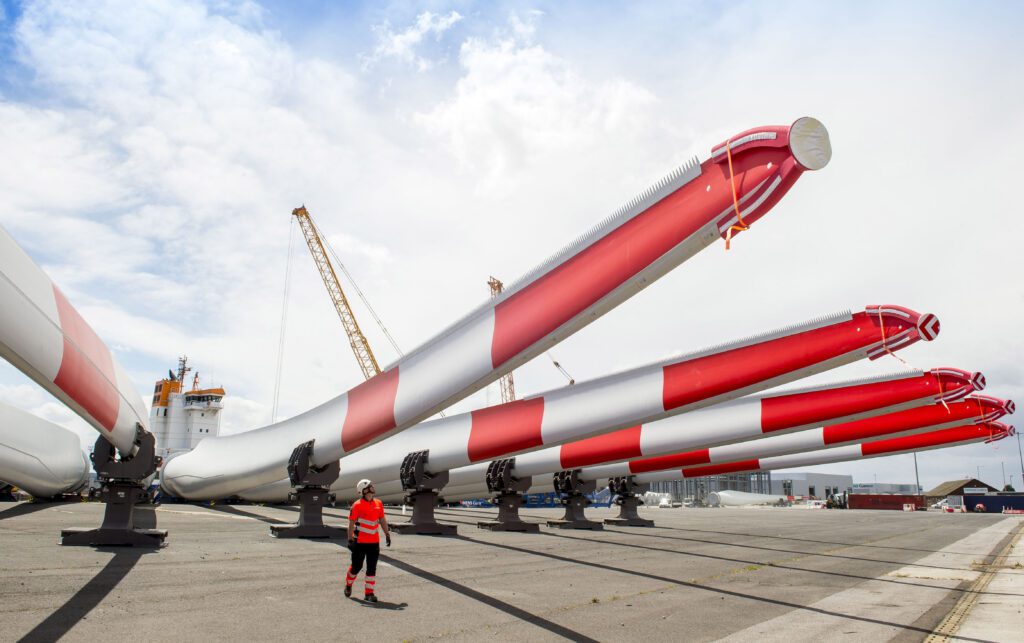Recyclable Blades Featured at New RWE Offshore Wind Farm Near Denmark
Recycling of components used in the renewable energy sector is a growing industry. Several companies have entered the market to make wind and solar power more sustainable, including some of the largest players in renewables.
RWE, the Germany-based global energy provider, on June 14 announced that 40 of the wind turbines at its Thor offshore wind farm off the coast of Denmark will be equipped with recyclable rotor blades made by Siemens Gamesa at a factory in Europe. In addition, RWE on Wednesday said the Thor installation will be the first worldwide to feature carbon dioxide (CO2)-reduced steel towers, also from Siemens Gamesa. RWE said the use of these materials at Thor is part of the company’s strategy to make renewable energy more sustainable.
The 1,008-MW Thor wind farm will feature 72 SG 14-236 DD turbines from Siemens Gamesa.
RWE said half of the Thor project’s turbines will sit on the GreenerTower from Siemens Gamesa. The company said the tower’s manufacturing features a CO2 reduction of at least 63% in the tower steel plates, compared to plates made with conventional steel.
“RWE has demonstrated a clear commitment to lead on circularity across the offshore wind sector by using recyclable blades at now three offshore wind projects,” Sam Eaton, CEO of RWE Offshore Wind Holdings, told POWER, noting the use of recyclable blades could support the nascent U.S. offshore wind industry. “The adoption of recyclable wind turbine blades is an integral part of achieving RWE’s net-zero targets and presents a great opportunity to make sustainability inherent to the burgeoning U.S. offshore wind industry.”
RWE is the largest leaseholder in the New York Bight offshore wind development area. The company also holds a lease to develop wind power off the coast of California.
Circularity, Net-Zero Emissions
“At RWE we are fully committed to working towards circularity and net-zero emissions. We are already testing the world’s first recyclable wind turbine blades under real-life conditions at our German offshore wind farm Kaskasi and we have decided to install them at Sofia. By using these rotor blades at our Thor offshore wind farm, too, RWE continues lead the way towards a circular offshore sector,” said Sven Utermöhlen, CEO of RWE Offshore Wind and based in Germany. “And we are doing even more. We are the first developer in the world to pilot Siemens Gamesa’s CO2-reduced steel towers, which significantly reduce the carbon footprint of wind turbines. This is the right direction for the future of our sector, which has sustainability at its core.”
The Thor wind farm will be in the Danish North Sea, about 14 miles from Thorsminde on the west coast of Jutland, a peninsula comprising several regions of Denmark. RWE said the installation should be fully operational by year-end 2027.
RWE owns and operates offshore wind installations throughout Europe representing a total of 2.4 GW of generation capacity.
Recycling Components
Wind turbines are made primarily of steel, and scientists have said about 90% of their structure could be recycled. But recycling of wind turbine blades has been challenging, in part because their components have been difficult to separate. Chemists from Aarhus University in Denmark recently published a study in which they said they had found a way to break apart the strong glue that holds blades together, enabling the reuse of a blade’s main components.
The ZEBRA (Zero wastE Blade ReseArch) consortium in March 2022 announced the manufacture of what it called the first 100% recyclable prototype wind turbine blade, using Arkema’s Elium liquid thermoplastic resin and new high-performance glass fabrics.

Siemens Gamesa in Wednesday’s announcement said a new type of resin with a special chemical structure enables the composite materials in the company’s RecyclableBlade product to be separated again. The company said the process means the properties of the individual materials stay intact, enabling their use in new casting applications—which could be in other industries, such as vehicle manufacturing or consumer goods.
“More than one million tons of blade material are expected to be installed globally every year. Our recyclable blades can avoid those materials ending their life in a landfill and give them a second use,” said Maximilian Schnippering, head of Sustainability at Siemens Gamesa. The company has said it wants 100% of its wind turbine components to be recyclable by 2040.
Siemens Gamesa said the 342-MW Kaskasi offshore wind project represents the first use of fully recyclable offshore wind turbine blades. The technology was launched in September 2021, and installed at Kaskasi in July 2022. The Kaskasi installation, located about 22 miles north of the island of Heligoland in the German North Sea, features SG 8.0-167 DD turbines.
—Darrell Proctor is a senior associate editor for POWER (@POWERmagazine).